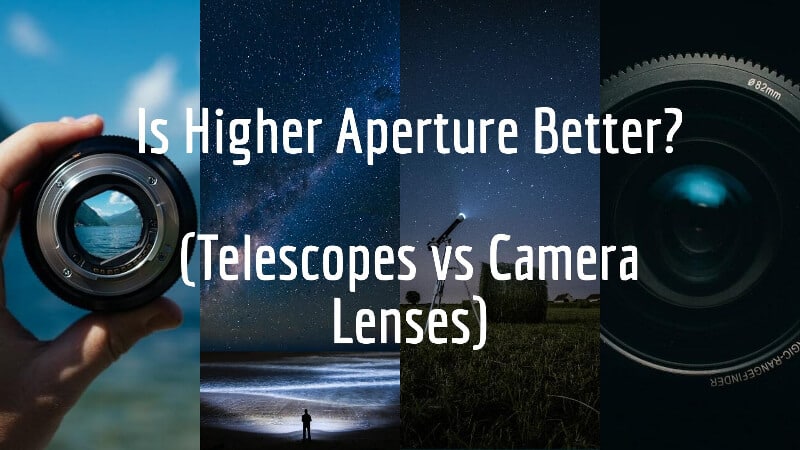If you are confused about aperture don’t worry, it is a fairly muddled concept.
It is a term used differently for telescopes and camera lenses, despite them being very similar optical devices.
In this article, we hope to quickly and clearly clarify this.
Aperture in Telescopes
- Aperture in a telescope is the size of the lens (for refractor telescopes) or mirror (for reflector and compound telescopes).
- It is the best measure of the telescope’s light collecting capacity, which is vitally important since it will be used in low light to look at the night sky.
- Aperture is therefore the best measurement of a telescope’s power and viewing capacity.
- With telescopes, the aperture is measured in either millimeters or inches.
To read more on this, see What is Telescope Aperture?
Is Higher Aperture Better in Telescopes?
Generally, higher aperture is better in telescopes. The higher it is, the more light it will collect and the better the images it will provide.
The only downsides to this are that higher aperture telescopes cost more and are larger and heavier.
See the Most Powerful Telescopes You Can Buy if you want to find high-aperture models.
Telescope Aperture, Focal Length, and Focal Ratio
If you know the telescope’s aperture and focal length (the distance inside the telescope from the lens/mirror to where the light is focussed) you can also calculate its focal ratio.
The formula for this is:
focal length (mm) / aperture (mm) = focal ratio (f/ number)
See our free Focal Ratio Calculator for this.
For example, a Celestron 8″ RASA telescope has:
- 203mm aperture
- 400mm focal length
- f/2 focal ratio
Focal ratio in a telescope is a measure of how fast it gathers light. I.e. the faster the focal ratio, the quicker it will gather the light needed for the image and the shorted the exposure time needed.
Focal ratio is written as an f-number, e.g. f/4, f/11. The lower this is, the faster the focal ratio.
This can be a reason for confusion, as a lower f-number means a higher focal ratio.
I know we have diverged from aperture a bit here, but now we will look at aperture in camera lenses and hopefully it will make sense.
Aperture in Camera Lenses
Aperture in camera lenses is a measure of the size of the opening of the lens which also determines how much light it lets in.
What is different from telescopes though is that the f-number (focal ratio in telescopes) is what is given as the aperture measurement of a lens.
For example, the Sigma Art 14mm f/1.8 lens has a:
- Focal length of 14mm
- Aperture of f/1.8
Therefore aperture in camera lenses is not a size measurement in millimeters or inches, but rather a ratio measurement that indicates how fast it is.
The lower the f-number, the smaller the aperture and the faster the lens is.
Therefore, if you were to ask the question ‘Is 1.8 or 2.2 aperture better?’, then the answer is f/1.8, as it is faster.
Is Higher Aperture Better in a Lens?
This question can then be confusing as:
- Sometimes higher is used to mean faster and therefore a smaller aperture with a higher f-number, but
- Sometimes higher is used to mean wider aperture and therefore slower with a lower f-number.
It is therefore better practice with camera lenses to use either fast or slow aperture.
Faster aperture in a lens is better for low-light photography, including astrophotography. This is because the lens is then better at gathering light:
- For astrophotography, this means longer exposures before any star trails occur.
- For other low-light photography (i.e. indoors), it can mean using a fast shutter speed without having the ISO really high and degrading the images.
However, aperture also impacts the depth of field where:
- Fast aperture means a shallow depth of field with a lot of background blur. This can be great for portraits or similar.
- Slow aperture means a deep depth of field with no background blur and everything in focus. This is most desirable for landscape photography.
Here is a good video explaining lens aperture:
Is Higher Aperture Better?
Overall, you can summarize this as:
- Aperture in a telescope is a size measurement of its lens or mirror. It is a good indicator of how well it collects light and performs as a tool for astronomy or astrophotography.
- The speed of a telescope is indicated by its focal ratio. The lower the number, the faster it is at capturing light.
- Aperture in a camera lens is given as an f-number like the focal ratio of a telescope. Again, the lower the number, the faster it is at capturing light.
Therefore:
- “High aperture” in a telescope mostly likely equals good
- “High aperture” in a camera lens is a bit more complicated and could be used to mean faster (smaller) or wider (slower).
We hope that has helped you understand whether higher or lower aperture is better in telescopes and camera lenses.
Related articles:



